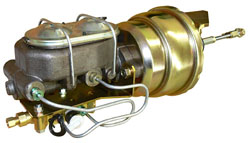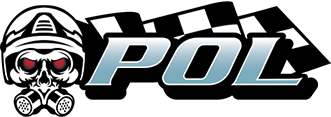
- BB-T4755
NOTE: Booster may differ from picture depending on type of booster options you have chosen.
IMPORTANT: This kit is assembled for shipping
purposes only! Be sure to check all nuts and bolts for adequate torque prior to use. Don’t forget! Make sure this kit fits your application before painting or plating. Beware that chroming or painting the booster can cause it to malfunction if not performed properly. Parts that have been painted, plated or modified may not be returned.
STEPS: Read these instructions carefully before attempting this installation!
- Remove original master cylinder, pedal clevis and hard lines.
- Clean and prep the frame, as the new booster bracket mounts off of the original master cylinder mounting bracket.
- Remove master cylinder from power booster, as you will need to bench bleed it prior to bleeding the system. Inexpensive bleeder kits are available at any auto parts store for minimal cost.
- Install the booster assembly onto the original bracket that mounted the master cylinder to the frame. You will need to drill three additional holes to finish mounting the bracket assembly. A 3/8” drill bit is required and the locations of the holes are determined once the bracket is secured to the original mount.
- Mount the heim joint to the pedal with supplied hardware and check for proper adjustment by making sure the brake pedal is all the way up and no pressure is being applied to the booster. Be sure to tighten the heim joint jam nut. 1947-54 Applications: Make sure the 1/2” spacer is between the pedal and heim joint. 1955-59 make sure the 3/8” thick washer is between heim joint and pedal extension
bracket. - Mount your bench bled master cylinder to the power booster. Connect all appropriate hard lines and bleed the system. Note: Disc brake applications see prop valve diagram for line port configurations. Drum brake applications use the port closest to the power booster for plumbing the rear brakes. No proportioning valve required on drum brake applications.
- If you are running disc brakes be sure to have the proper proportioning valve kit for your application.
- Double check all of your work and proceed to check the system for any leaks.
- Be sure to hook up your vacuum line to the appropriate port on the manifold.
- On 1947-54 applications we supply a large spacer to take the place of the clutch pedal as it is very difficult to run power brakes with a
manual transmission on these particular trucks.
Recommendations:
- We highly recommend that you perform a vacuum check on your particular engine. Acceptable vacuum numbers would be from 15in/hg to 22in/hg. For those who have lower numbers we offer a vacuum pump. Call for details.
- We also offer disc brake master cylinders and proportioning valves for those who do not want to run power brakes. Call for details.

just wondering, my customers 55 chevy truck has had a engine & trans converison done on it 350engine & 400 trans, will there be room for the booster and master clyinder with this engine conversion? Currently looks like trans mounting support my get in the way.
Yes, you can run the power brake unit. Depending on the trans crossmember used, and where it mounted, you may need to use our trans crossmember as it mounts to the
bottom of the frame. See this link: http://www.performanceonline.com/1947-59-GMC-TRUCK-AND-CHEVY-TRUCK-TUBULAR-TRANSMISSION-CROSSMEMBER-TCM4759-16565/
Looking for brake booster for 1945 GMC will the 47-55 work ? Plan on get 4959wbk-6 disc kit. What would the total cost be?
Thanks
Valentine
Please contact us at info@performanceonline.com
Thanks